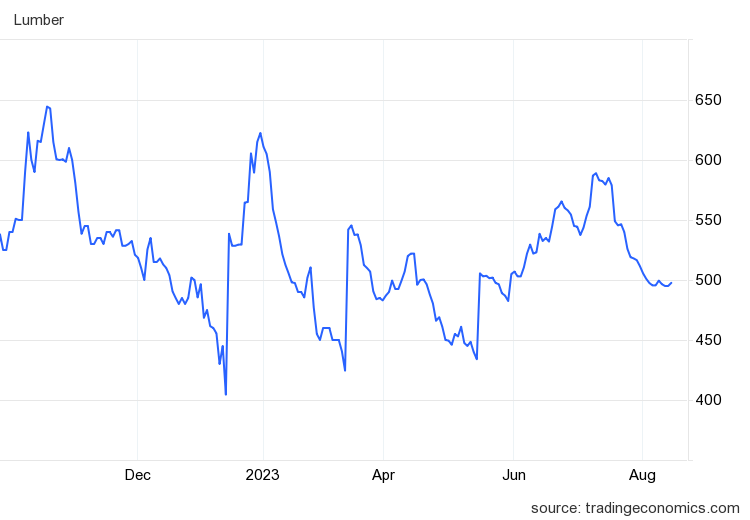The lumber forecast and futures extended losses below $500 per thousand feet, the lowest in over two months driven by concerns about weakening demand, despite a decrease in supply.
Housing, Supply Chain, Fires Are Factors
Housing starts tumbled 8% month-over-month in June reaching a seasonally adjusted annualized rate of 1.434 million, following a downwardly revised 15.7% jump in the previous month.
Shipments from Canada, the US’s biggest supplier, are expected to decline after wildfires have led to a record-breaking 9.2 million hectares of forest burned so far this season. This comes on the back of production cutbacks in British Columbia and a slowdown in European wood shipments.
Lumber is expected to trade at 470.93 USD/1000 board feet by the end of this quarter, according to Trading Economics global macro models and analysts expectations. Looking forward, we estimate it to trade at 407.48 in 12 months time.
Historical Lows and Highs
Historically, Lumber reached an all time high of 1711.20 in May of 2021. Lumber – data, forecasts, historical chart – was last updated on August of 2023.
In recent times, lumber futures have experienced significant volatility. The market saw a sharp increase in prices during the COVID-19 pandemic as demand for housing and home renovations surged. However, prices have since retreated from their peak levels as supply has caught up and demand has moderated.

Factors Influencing Lumber Future Forecasts
The recent decline in lumber futures below $500 per thousand feet can be attributed to concerns about weakening demand. Housing starts, an important indicator of demand for lumber, dropped 8% month-over-month in June. This decline, coupled with production cutbacks in British Columbia and a slowdown in European wood shipments, has raised worries about a potential oversupply in the market.
Additionally, wildfires in Canada have led to a significant reduction in shipments from the country, exacerbating supply concerns. These wildfires have burned a record-breaking 9.2 million hectares of forest so far this season. Canada is the largest supplier of lumber to the United States, so any disruptions in its supply chain can have a substantial impact on prices.
Looking ahead, Trading Economics global macro models and analysts expect lumber futures to trade at around $470.93 USD/1000 board feet by the end of the current quarter. However, they anticipate further declines in the coming months, with a projected price of $407.48 in 12 months.
Lumber Forecast Overview
Lumber is wood that has been processed into beams and plank. The biggest producers of lumber are concentrated in the Baltic Sea region and North America. The futures contract traded on Chicago Mercantile Exchange specifies that the lumber must be manufactured in certain U.S. states and Canadian provinces and meet specific quality standards.
It is important to note that lumber prices can be highly volatile, and their prices are influenced by various factors such as supply and demand dynamics, economic conditions, weather events, and government policies.
Therefore, these forecasts should be taken as estimates and not definitive predictions.
